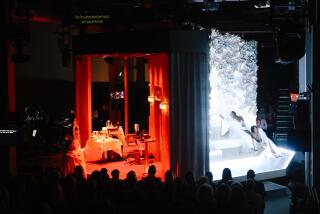‘La Stupenda’ Joan Sutherland to Take Last Bow
- Share via
SYDNEY, Australia — Joan Sutherland, one of the great sopranos of the 20th Century, will make her farewell operatic performance here next week--saying goodby to the stage in the city where she was born 63 years ago.
Idolized as “La Stupenda” by the audience at Milan’s La Scala, Sutherland is due to end her career at the Sydney Opera House on Tuesday with a performance of Meyerbeer’s “Les Huguenots.”
“I feel it’s been such a wonderful career I don’t want to go on until somebody starts saying: ‘I do wish the old girl would get off. She’s not what she used to be,’ ” Sutherland said recently.
“I’ve got to an age where I don’t want that routine or that discipline anymore. I want to do things that other people count as everyday,” she said.
Sutherland is ranked with Maria Callas as the most important female influence on opera since World War II, enlarging the repertoire of the soprano to include coloratura roles forgotten since the 19th Century.
In the 31 years since she stunned London’s Covent Garden with her performance in the title role of Donizetti’s “Lucia di Lammermoor,” Sutherland has been idolized for her powerful voice and Wagnerian stage presence.
Increasing problems with arthritis and fears that her voice was showing its age persuaded Sutherland to retire.
Sutherland made her stage debut in Sydney in 1951. That was before the days of the Sydney Opera House, and Australia had limited opportunities for a budding soprano, so she left for London.
After studying at the Royal College of Music, Sutherland was hired by the Covent Garden company. She made her British debut in Mozart’s “The Magic Flute” in October, 1952.
By then she was being coached by conductor Richard Bonynge, whom she would marry in 1954.
“I first heard her voice in 1947 or 1948. I thought it was a wonderful voice, but I thought it was a cold voice and not a communicative instrument at that time,” Bonynge said in a recent interview.
Bonynge was convinced that Sutherland should veer from the obvious operatic road toward Wagner and Strauss and develop a coloratura voice of dramatic, florid flourishes.
Since the turn of the century, coloratura parts had been sung by “canaries,” sopranos with light, pure voices, but Sutherland was to change this, resurrecting operas such as Donizetti’s “Lucrezia Borgia” and “La Fille du Regiment” with her rich voice.
Sutherland was initially doubtful about the change of style, but Bonynge’s advice proved the basis of his wife’s lasting fame, which began on Feb. 17, 1959, the first night of “Lucia di Lammermoor,” directed by Italy’s Franco Zeffirelli.
Sutherland came down the stairs in a blood-stained nightgown in Lucia’s mad scene, and she was hailed a star after a performance dubbed by one critic as one of the greatest sensations in operatic history.
Since then she has sung in 48 operas, made more than 80 recordings and appeared onstage with most of the postwar greats.
Now a grandmother--Sutherland’s only son has two children--she plans to spend her retirement writing an autobiography and traveling, although she has not ruled out a return to the recording studio.
More to Read
The biggest entertainment stories
Get our big stories about Hollywood, film, television, music, arts, culture and more right in your inbox as soon as they publish.
You may occasionally receive promotional content from the Los Angeles Times.










